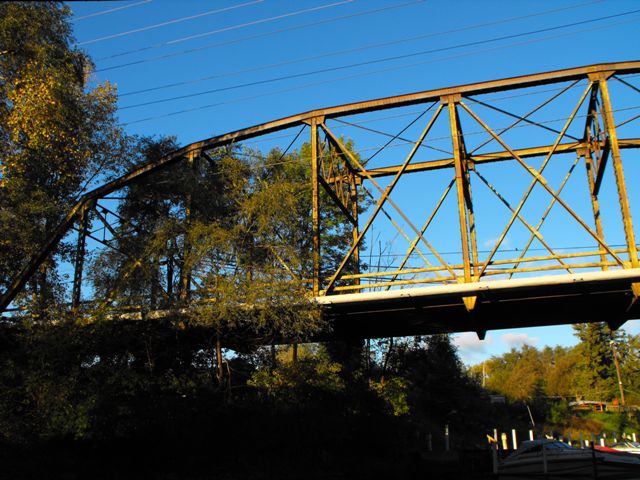We Recommend:
Bach Steel - Experts at historic truss bridge restoration.
BridgeHunter.com Phase 1 is released to the public! - Visit Now
Crisman Road Bridge
Porter County Bridge 1013

Primary Photographer(s): Nathan Holth
Bridge Documented: October 1, 2010
Rural: Porter County, Indiana: United States
By Builder/Contractor: Unknown and Engineer/Design: Indiana State Highway Commission
Not Available or Not Applicable
145.0 Feet (44.2 Meters)
154.0 Feet (46.9 Meters)
19.7 Feet (6 Meters)
1 Main Span(s)
6400130

View Information About HSR Ratings
Bridge Documentation
View Archived National Bridge Inventory Report - Has Additional Details and Evaluation
This bridge is a good example of a state standard plan truss bridge in Indiana. This bridge is closed to vehicular traffic and originally carried Crisman Road, which may have been an earlier alignment for what is today the large, divided IN-294 highway. The IN-294 Bridge is located right next to this bridge, and the IN-294 Bridge as such serves the needs of those who once used Crisman Road Bridge.
The eight panel truss is composed as follows (measurements accurate within .25 inches): End posts and top chord: back-to-back channels with v-lacing and cover plate, 16 by 12.5 inches. Bottom chord: Two pairs of angles with battens, 8 inches by 12.5 inches. Vertical members: back-to-back channels with v-lacing on each side, 8 inches by 13 inches and 6 inches by 13 inches. Diagonal members: two angles with cover plate on one side, 5.25 inches by 8 inches and 3.25 inches by 8 inches. Both Portal and Sway bracing: two pairs of angles, and entire space between spanned by a single row of lattice composed of angles. Floorbeams: rolled American Standard Beams (i-beams). Deck stringers: rolled American Standard Beams (i-beams). Lateral bracing (both overhead and under deck): angles. Deck: corrugated metal base with asphalt surface. Railing: two channels, each measuring 5 inches by 3/4 inch, and spaced 11.5 inches apart from each other. Identified steel mill names: Inland.
Contrary to the DHPA survey findings, the channel railings on this bridge appear to be original, and if not, are quite old. The bridge is no longer listed in the National Bridge Inventory, and as such it is unclear who actually owns this bridge currently.
Information and Findings From DHPA Historic Bridge SurveyStatement of Significance The IDH [Indiana Department of Highways] began to reinforce the standard design for 150' Parkers around 1930. These outer panels of the lower chord and the portal bracing have been strengthened on this bridge. It is an early example of modifications that soon led to a revised standard plan. Aside from contemporary guardrails, the structure appears to retain all its original members. Architectural Description The Indiana Department of Highways followed its reinforced standard 150' Parker through truss design for this setting, including the concrete substructure. Eight panels, demarked by differently sloped top-chord segments, compose the single-span riveted superstructure. The verticals are made of laced channels. A pair of angles and battens, lighter toward midspan, provide the diagonals and counters (used only in the two most central panels). The lower chord consists of two pairs of angles riveted together with battens. Extra-substantial portal and wind bracing support the trusses. The heavy I floor beams are riveted to the verticals at and above the lower chord and carry the 19'9" asphalt-filled metal pan roadway. Bridge Considered Historic By Survey: Yes |
![]()
Photo Galleries and Videos: Crisman Road Bridge
Bridge Photo-Documentation
Original / Full Size PhotosA collection of overview and detail photos. This gallery offers photos in the highest available resolution and file size in a touch-friendly popup viewer.
Alternatively, Browse Without Using Viewer
![]()
Bridge Photo-Documentation
Mobile Optimized PhotosA collection of overview and detail photos. This gallery features data-friendly, fast-loading photos in a touch-friendly popup viewer.
Alternatively, Browse Without Using Viewer
![]()
Maps and Links: Crisman Road Bridge
Coordinates (Latitude, Longitude):
Search For Additional Bridge Listings:
Bridgehunter.com: View listed bridges within 0.5 miles (0.8 kilometers) of this bridge.
Bridgehunter.com: View listed bridges within 10 miles (16 kilometers) of this bridge.
Additional Maps:
Google Streetview (If Available)
GeoHack (Additional Links and Coordinates)
Apple Maps (Via DuckDuckGo Search)
Apple Maps (Apple devices only)
Android: Open Location In Your Map or GPS App
Flickr Gallery (Find Nearby Photos)
Wikimedia Commons (Find Nearby Photos)
Directions Via Sygic For Android
Directions Via Sygic For iOS and Android Dolphin Browser
USGS National Map (United States Only)
Historical USGS Topo Maps (United States Only)
Historic Aerials (United States Only)
CalTopo Maps (United States Only)

